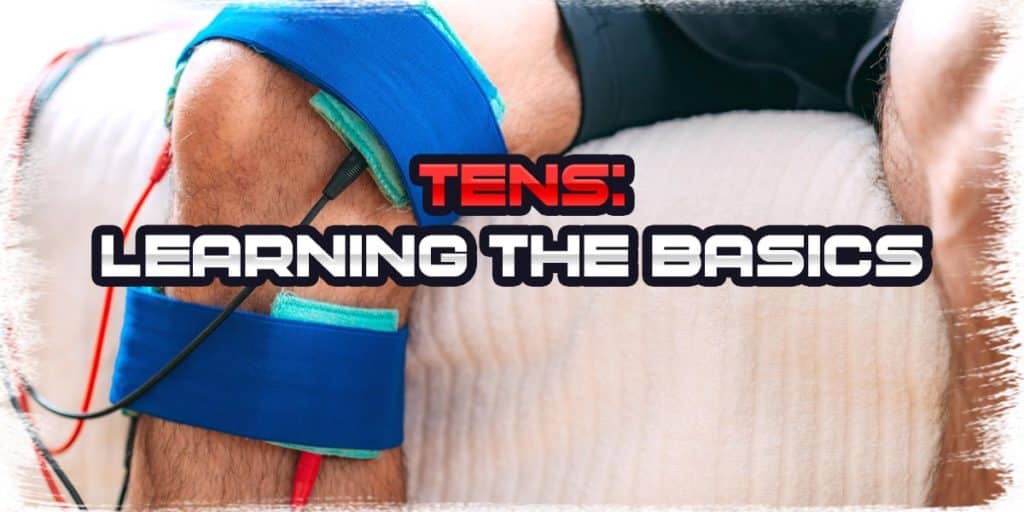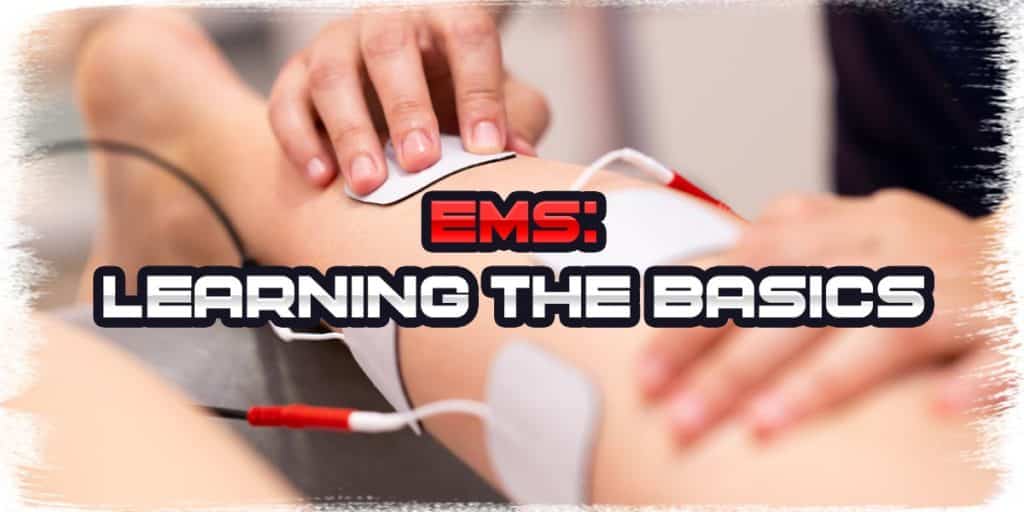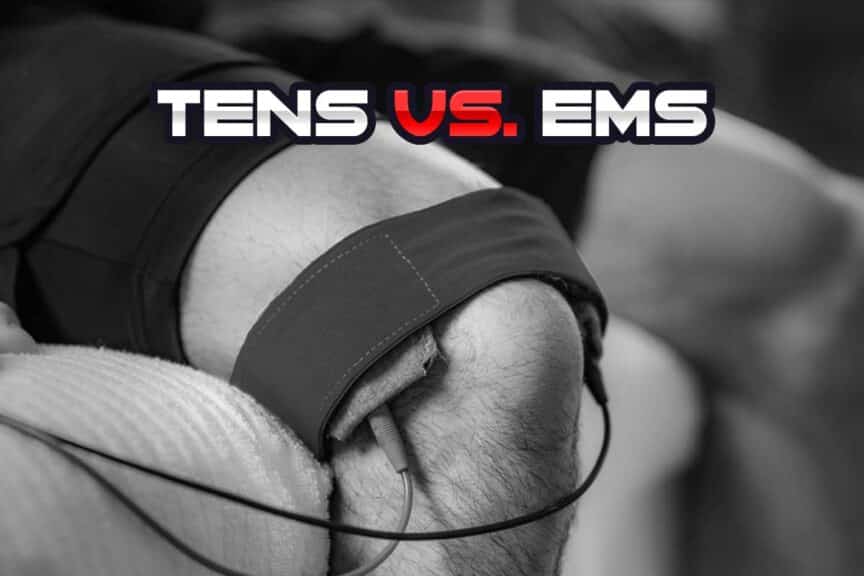If you’re wondering what the difference is between TENS (transcutaneous electrical Nerve Stimulation) and EMS (Electrical Muscle Stimulation), you’re not alone. This is a common question that many people have, including my patients within the clinic.
But fear not! This article will break down the differences between these two devices and help you understand when each one is best used.
Both TENS and EMS are forms of electrotherapy, which deliver an electrical current from a small device to a targeted body part. TENS is strictly used for pain relief by stimulating nerves in the skin. EMS is used to activate and strengthen muscles and is most often used for rehabilitative purposes.
If you want to learn more about the specifics of each of these therapeutic devices, then be sure to keep on reading!
ARTICLE OVERVIEW (Quick links)
Click/tap on any sections below to instantly jump to that particular section!
The basics of TENS devices
– How TENS devices block out pain
– Different modes of TENS delivery
– When to use a TENS device
– When not to use a TENS device
The basics of EMS devices
– How EMS devices work
– Different parameters of EMS delivery
– When to use an EMS device
– When not to use an EMS device
Medical Disclaimer: While I am a physical therapist, I am not YOUR physical therapist. As a result, I cannot tell you whether or not any treatments mentioned on this website may or may not be appropriate for you, including using TENS and/or EMS devices. By following any information within this post, you are doing so at your own risk. You are advised to seek appropriate medical advice for any pain you may be experiencing.
As a quick terminology guide: the terms EMS and NMES are often used interchangeably. NMES stands for Neuromuscular Electrical Stimulation. So if you hear or read about NMES, know that it is the exact same thing as EMS, just with a different name.
The basics of TENS devices

Transcutaneous Electrical Nerve Stimulation (TENS) serves its primary purpose by blocking out musculoskeletal pain (pain arising from muscles, tendons or joints) that a given individual is experiencing.1 It can be used to block out pain from acute (newly acquired) injuries or for blocking out and managing chronic pain (pain that has been around for more than three months).2
TENS devices by themselves don’t offer any direct healing properties to the underlying issue that’s causing pain or discomfort. Rather, TENS simply overrides the pain signals being interpreted by the brain (described further in the section below).
Like EMS, TENS devices can utilize two or four electrode configurations that can be placed on the skin. Whether an individual chooses to utilize a two-electrode or four-electrode setup can depend on various circumstances, such as the size of the painful area being treated and the location in which the pain is occurring.
I often recommend a simple two-electrode approach for the vast majority of individuals.
Unlike EMS, TENS devices don’t offer any strengthening to muscles since the electrical current provided by the device only stimulates the nerves in the skin and not the nerves within the muscles beneath the skin.
How TENS devices block out pain
TENS devices create their pain-relieving effects by delivering the right amount of electrical current to the sensory nerves that detect sensations on our skin. These types of nerves are known as cutaneous nerves. When these nerves are stimulated by the electrical current from the TENS device, they carry the sensory information up to the brain on a neurological pathway known as a tract.
The tract that carries information to the brain to inform it about the buzzing/tingling being felt on the skin from the TENS device is a separate tract from the one that carries information to the brain about pain.
And here’s where the magic happens…
The brain isn’t very good at interpreting two very different sensations (i.e. pain and buzzing/tingling) at the same time. As a result, the brain essentially becomes distracted from the pain signals and instead focuses on the gentle buzzing/tingling sensations it’s receiving instead.
This phenomenon is known as the gate control theory of pain (link takes you to the Wikipedia article if you’d like to read more about it).
It’s the exact same reason why we feel better when we rub our skin after clumsily bumping that area into an object. We naturally tend to rub the sore or aching area because the stimulation of the cutaneous nerve receptors in the skin overrides the pain signals being delivered to the brain. So long as these cutaneous nerve receptors are stimulated, we essentially block out the pain. TENS devices can offer great reprieve when we need to dull the pain or block it out.
It’s important to note that a TENS machine won’t “cure” or “fix” the underlying issue that’s causing the pain, so I wouldn’t go using one with the erroneous belief that it will heal the issue; it’s simply a way to help our brain and ourselves experience a break from pain and discomfort. But there can be an indirect healing effect from letting the brain have a break from experiencing continual pain.
Different modes of TENS delivery
If you want all of the geeky details of TENS parameters, you can read about them in this journal article:
Transcutaneous Electrical Nerve Stimulation: Mechanisms, Clinical Application and Evidence
Otherwise, you can find consolidated tables and information below.
The electrical characteristics for which TENS is used can be manipulated to varying degrees as a means to deliver differing pain-relieving effects. Some modes of TENS delivery include conventional TENS, acupuncture-like TENS, Brief intense TENS and Noxious TENS. A short description of each is listed below.
Conventional TENS
This is by far the most commonly used TENS setting.
This mode of TENS works by delivering electrical pulses that have a short duration, a high frequency, and lower current amplitude. These parameters usually elicit a mild tingling sensation over the area being targeted. It is usually used for pain relief during general daily activities and only produces its pain-relieving effects while in use.
Acupuncture-like TENS
With this mode of TENS, there is a delivery of electrical pulses consisting of longer duration, lower frequency and moderate current amplitude. It often produces muscle twitches (but not full contractions). It is often uncomfortable during its application; however, it can elicit pain-relieving effects for hours after stimulation ceases.
This mode is not typically implemented while producing daily movements or activities since muscle twitching can interfere with our ability to produce movement.
Brief intense TENS
Brief intense TENS consists of delivering electrical pulses that are of longer duration, high frequency and moderate current amplitude. Under these settings, it typically elicits paresthesia (altered sensation) and even a movement response from muscles. Individuals sometimes choose to use this configuration of parameters to minimize discomfort during activities that may otherwise be painful without this stimulation occurring.
Noxious TENS
As the name implies, noxious TENS is typically not a comfortable mode of TENS delivery. It is also not commonly used since it involves using a tiny probe-like electrode. The stimulation is typically delivered in intervals ranging from 30 seconds up to one minute over various portions of muscles.
When to use a TENS device

NOTE: Always be sure to consult with a qualified healthcare or medical professional in order to know if a TENS unit is safe for you to use with your pain and condition.
TENS devices are best used for conditions in which reduction in the sensation of pain is the desired outcome. Due to the therapeutic effects that TENS can provide, TENS may be appropriate for various types of pain, such as:
- Acute pain (pain from a newly acquired injury or condition)
- Chronic pain (pain from an injury that has been ongoing for more than 3 months)
- Myalgic pain (pain arising from muscles and tendons)
- Arthralgic pain (pain arising from joints)
Related Article: Vibrating Massage Balls: Here’s Some Effective and Nifty Benefits
When NOT to use a TENS device

TENS devices are not suited for a number of conditions and/or types of pain.1,3 They also should not be used on specific areas of the body. Reasons to not use TENS for pain can include (but are not limited to):
- Altered/diminished or absent sensation over the treated area
- Over areas of infection, open wounds or active bleeding
- Over or near certain areas on individuals with certain cardiac arrhythmias, pacemakers and implants
The basics of EMS devices

Electrical Muscle Stimulation (EMS) is often referred to as Neuromuscular Electrical Stimulation (NMES), so keep that in mind if you encounter either abbreviation.
The main goal of EMS/NMES is to help with muscle activation (i.e. helping muscles to contract). This is often used as a technique to activate and strengthen muscles that are otherwise having difficulty contracting on their own.
Related article: Does EMS Help with Weight Loss? Here’s Why You Don’t Want it to
When muscles do not receive enough electrical activity by the body’s own electric system (AKA the nervous system), they can be at risk for becoming weak, decreasing in size and even becoming painful to try and use.
The theory behind EMS is that providing an external electrical current to the targeted muscles can help maintain and preserve strength and function for those muscles.
From this standpoint, it can be debated how effective EMS is when it comes to helping individuals with specific neuromuscular injuries (injuries pertaining to the nervous system and muscular system) for their therapeutic rehab. Nonetheless, a large body of evidence in the scientific literature shows favourable outcomes for helping individuals maintain strength and functional abilities during rehabilitation while even improving recovery timeframes.4,5
How EMS devices work
EMS devices work just like TENS devices in that they deliver electrical current to the targeted area through the use of electrode pads that are placed on the skin over said area. The placement of the electrode pads is much more specific and targeted with EMS than compared to TENS.
Unlike TENS, however, the goal with EMS is to produce a sufficient muscle contraction without causing discomfort to the individual. Therefore, ideally, one of the electrode pads should be placed over the muscle’s motor point, which is the spot on the muscle that produces maximal muscle contraction while requiring a low stimulus threshold to do so.
Different parameters of EMS delivery
When it comes to setting the most ideal parameters for optimal therapeutic effectiveness, EMS can get a bit confusing at times, even for healthcare practitioners. This is mainly because there are several different factors or parameters that can all play off one another for achieving muscle stimulation that is ideal for the individual and their rehabilitative circumstances.
If you want all of the geeky details of EMS parameters, you can read about them in this journal article:
Can the Use of Neuromuscular Electrical Stimulation Be Improved to Optimize Quadriceps Strengthening?
Otherwise, you can find consolidated tables and information below.
Parameters most often used with EMS devices include the current amplitude, pulse duration, frequency, duty cycle, ramp time and overall treatment time. A very brief description of each is listed below.
Current amplitude
Current amplitude refers to the intensity of the electrical waves being emitted by the EMS unit. In this context, it determines the extent of muscle contraction that occurs underneath the electrode pads. The greater the current amplitude, the greater the extent of muscle contraction.
Pulse duration
The pulse duration setting determines how long the specified electrical current is delivered to the targeted muscle(s). A pulse duration should be long enough that it provides enough current to effectively build up stimulation in the muscle by overcoming a muscle’s natural capacitance.
Frequency
Frequency refers to the number of times that the electrical energy wave repeats per second. A pulsed current is used for EMS, with ideal frequencies being between 35-50 pulses per second. This frequency typically allows for a sustained (tetanic) muscle contraction to occur.
Duty cycle
Duty cycle refers to the portion of time that the EMS signal is on over a set period, with a period being the time required to complete an on-off cycle. It can be expressed as a ratio or a percentage.
As a quick example, if the EMS unit were set for providing a five-second muscle contraction (“on”) and the unit provided a ten-second break (“off”) before the next contraction phase bean, the duty cycle would be 1:2 or 50%
If the duty cycle were set too high, it would likely result in a greater propensity to fatigue the muscle(s) more quickly, which may not be ideal. Typical duty cycles for EMS have an “on” time of 6-10 seconds, with a recommended “off” time being around five times longer.
Ramp time
The ramp time on an EMS unit refers to the amount of time it takes for the electrical signal to gradually increase to full strength and decrease from full strength to absence. Ramping on EMS is important as it is much more tolerable for the electrical stimulation to the muscle to be gradually increased and decreased than to simply have a sudden, instantaneous electrical signal delivered to the muscle(s). A comfortable ramp time up to full signal is usually 2-4 seconds.
Treatment time
Treatment time simply refers to the duration of time the unit is used for its therapeutic purposes. A minimum of ten contractions is often recommended, while the maximum is usually twenty. With a typical duty cycle in place, it would take around twenty minutes to complete twenty muscle contractions.
When to use an EMS device

EMS devices are used when the rehabilitative goal or targeted outcome is based on maintaining neuromuscular strength and function. It is often used as a post-surgical treatment to stimulate muscles that have been impaired from the surgery; post-operative patients may have a hard time contracting muscles on their own for various reasons.
The use of an EMS device should be viewed more as a device to maintain neuromuscular health during the rehabilitative process rather than to solely improve the underlying condition all on its own. In other words, it may be best for the individual to use EMS to assist with a certain portion of their rehabilitation as opposed to relying solely on the EMS to provide lasting changes to overall muscle strength and health.
Commonly used conditions for which EMS tend to be used can include:
- Atrophy of the muscle(s)
- Weakness of the muscle(s)
- Diminished range of motion from the muscle(s)
- Denervated muscle(s)
When NOT to use an EMS device

There are a number of conditions and circumstances for when EMS is not appropriate to use. The following list is an example of when it should not be employed. However, it is not an exhaustive list by any means.6
- Over areas with an absence of sensation
- Over areas of active infection, open skin wounds or active bleeding
- Over tumours or cancerous areas
- Over areas with bone fractures
Final thoughts
While TENS and EMS have similar properties in how they work to achieve their therapeutic outcomes, they are, in fact, used for very different reasons. Both have been used for multiple decades and have their respective places in the world of pain relief and therapeutic rehabilitation.
It’s important to have a clear understanding of what each electrotherapeutic device aims to achieve; misconceptions can lead to ineffective pain relief or treatment results at best and injury or further pain at worst.
If you’re considering using TENS or EMS as part of your therapeutic regimen, be sure to speak with a qualified medical or healthcare professional to ensure that it is appropriate for you to do so and that you will use either device with the safest and most effective parameters and treatment application possible.
Related article: Theracup: The ULTIMATE Review by a Physical Therapist (With Pictures)
References:
3. Johnson MI. Transcutaneous electrical nerve stimulation (TENS). Electrother Evid-Based Pract 4th Ed Edinb Churchill Livingstone. Published online 2008:253-296.
6. Reed B. The physiology of neuromuscular electrical stimulation. Pediatr Phys Ther. 1997;9(3):96-102.

Hi! I’m Jim Wittstrom, PT, DPT, CSCS, Pn1.
I am a physical therapist who is passionate about all things pertaining to strength & conditioning, human movement, injury prevention and rehabilitation. I created StrengthResurgence.com in order to help others become stronger and healthier. I also love helping aspiring students and therapists fulfill their dreams of becoming successful in school and within their clinical PT practice. Thanks for checking out my site!

